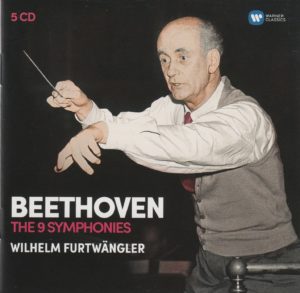
My listening post this morning is my office, with the trustworthy robot from Lost in Space keeping me company.
Also keeping me company are German conductor Wilhelm Furtwangler (1886-1954), the Stockholm Philharmonic Orchestra (now known as the Royal Stockholm Philharmonic Orchestra), and Beethoven’s Symphony No. 8 in F major.
I’ve encountered Maestro Furtwangler seven times previously, on…
 Day 7. Rating: Almost “Huzzah!”
Day 7. Rating: Almost “Huzzah!”
Day 25. Rating: “Meh!”
Day 43. Rating: “Huzzah!”
Day 61. Rating: “Meh!”
Day 79. Rating: “Huzzah!”
Day 97. Rating: “Meh!”
Day 115. Rating: “Huzzah!”
I already know what today will bring because I’ve been listening to Maestro Furtwangler’s performance since I parked my keister in my office chair to work on today’s blog entry.
First, though, a brief excerpt from the liner notes by Richard Osborne,
As the critic Hans Keller observed: ‘Stylistically, the Eighth Symphony is easy on the ear, especially if you don’t listen to it; once you do, your mind is fully occupied with the sheer pace of structural events, of violent contrasts chasing each other.’
Furtwangler would not have disagreed with that. The older Furtwangler became, the more he thrilled to the physical and intellectual immediacy of the Eighth. By accident or design, he left no studio recording. Of the three extant ‘live’ recordings, this 1948 Stockholm version is in many ways the most exciting, the one that lives dangerously.
 Beethoven wrote his symphonies in four parts (except for the Sixth, which is in five). The time breakdown of this particular one (Symphony No. 8 in F major), from this particular conductor (Furtwangler, at age 62) and this particular orchestra (the Stockholm Philharmonic Orchestra – now known as the Royal Stockholm Philharmonic Orchestra), at this particular time in history (November 13, 1948) on this particular record label (Warner Classics) is as follows:
Beethoven wrote his symphonies in four parts (except for the Sixth, which is in five). The time breakdown of this particular one (Symphony No. 8 in F major), from this particular conductor (Furtwangler, at age 62) and this particular orchestra (the Stockholm Philharmonic Orchestra – now known as the Royal Stockholm Philharmonic Orchestra), at this particular time in history (November 13, 1948) on this particular record label (Warner Classics) is as follows:
I. Allegro vivace e con brio…………………………………..8:06
II. Allegretto scherzando…………………………………….4:34
III. Tempo di menuetto……………………………………….5:51
IV. Allegro vivace………………………………………………….7:35
Total running time: 25:26
My Rating:
Recording quality: 3 (heavy tape hiss, obviously recorded off vinyl album, ambient noises, sounds flat and mono)
Overall musicianship: 4 (gets better with each listen)
CD liner notes: 4 (essays on Furtwangler written in English, German, and French, however historical details missing or hard to find: Where was this recorded? When? What orchestra? That information is in small print on the back of the CD sleeves)
How does this make me feel: 3 (“Meh!”)
This may be a fine performance. But this recording doesn’t do it justice.
This is clearly recorded from a vinyl album – and not even a vinyl album free of scratches. There’s more snap, cracklin’ and poppin’ going on here than in a bowl of Rice Krispies. And the snapping sounds like one of my old vinyl records used to sound – with the blemish heard with every rotation of the album.
That distraction, plus the flat/mono recording, makes for a tough listen.
And I know. I listened to this all the way through 7-8 times. It never got better. It only got more distracting.
Doubt me?
Try Movement I. There’s noise throughout.
Try Movement IV from about 4:10 to 4:40. Lots of crackles and pops.
I’m sure Maestro Furwangler and the Stockholm Philharmonic Orchestra played their butts off that night. But that doesn’t mean it’s worth listening to some 69 years after the fact.
“Meh!”
